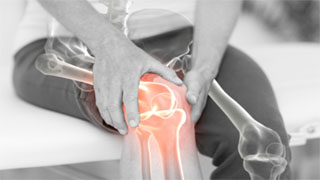
8 best knee joint strengthening exercises to make joints stronger and healthier. Experts say that these simple exercises are very suitable for you to exercise at home next time.
As you age, there is a part of your body that requires more care, and that is your knees. These joints are crucial because they bear the majority of your body's weight and are a key component of the simplest daily activities such as walking, climbing stairs, and even sitting and standing up, so you will notice if they begin to bear the burden of betraying you. That's why it's so important to combine knee strengthening exercises with age.
Although you cannot completely prevent some natural effects of aging or medical conditions (such as arthritis, which affects the knee joint by wearing down knee cartilage), knee weakness is often the result of mechanical problems, such as improper forms during exercise or injuries that affect your daily activities.
Neglecting proper knee care may lead to more imbalance, which may result in injuries to other parts of the body due to overcompensation.
Firstly, especially if you are currently experiencing pain, it is recommended to consult a professional, such as a physical therapist, first. They can evaluate your unique body movements and current condition or injury situation to develop an action plan to address the root cause of your problem.
Once you have gained some expert insights and can exercise at home, consider adding the knee strengthening exercises below to your daily routine - they will help you perform better in the gym and maintain strong energy in your daily life. But first, please make sure to spend 5 to 10 minutes warming up. The American College of Orthopaedic Surgeons recommends engaging in low impact activities such as walking or cycling before starting.
1. Kick your butt
Why it works: This exercise can serve as a good warm-up exercise for any of the exercises listed below, as it can move and relax the knee joint before starting the exercise and help prevent injury.
How to do it: If you need to grab something to maintain balance, stand against the wall, stand straight, and try kicking your butt with your heel. Kick 20 times on each side, alternate between two rounds, and rest between groups for 30 to 45 seconds.
2. Sit down and stand up
Why it works: This exercise can be done anywhere with a bench or chair. I like this exercise because it is something we do every day when we sit up from our desks or even sofas. When you sit down, this exercise can exercise muscle groups such as the quadriceps, hamstring, and gluteal muscles, and even your muscle groups. Your core plays a role in stabilizing your body.
How to do it: Use a bench or chair, slowly sit down with your arms on either side of your body, and lift up to maintain stability when sitting down. Then, slowly stand up and squeeze your hips when you reach the top. It is very important to focus on sitting slowly when coming down, as it allows you to pay more attention to the muscles you are exercising. You can also increase the risk of injury by accelerating to the bottom of the movement. Modify the movement by finding a slightly higher bench or chair, so you don't have to descend so low. Conduct 3 groups, with 15 sessions per group.
3. Hip bridge
Why it works: Hip bridges are very helpful because they can strengthen the gluteal muscles, which is important for knee health. A strong gluteal muscle can bear some load and prevent the knee from moving in directions that should not be entered, such as inward or outward rotation, thereby helping to reduce pressure on the knee.
How to do it: Lie on your back, bend your knees comfortably, place your feet on the ground, shoulder width apart. Starting from there, lift the hips off the ground and slowly and controlled squeeze them at the top, with a focus on contracting the hips at the top. Conduct 3 groups, with 15 sessions per group.
4. Leg Stretching
Why it works: This exercise can exercise your core muscles and hip flexors. Strengthening your core muscles and hip flexors can help you maintain posture and stabilize your spine, allowing you to move in the way your body should.
How to do it: Lie down, bend one knee, and straighten one leg. Your arms can be placed on both sides of your body. Then, lift the straight leg up to 90 degrees and slowly lower it down. Each leg is divided into 3 groups, with 15 sessions per group.
5. Sitting against the wall
Why it works: Sitting against a wall is an excellent exercise to enhance the quadriceps, which play an important role in absorbing the impact of daily activities such as running, jumping, and even walking.
How to do it: Find a wall, align your back with the wall, and place your arms on both sides of your body. Slide down and bend your knees no more than 90 degrees. The closer it is to 90 degrees, the greater the difficulty. Find your optimal position based on your current strength level and maintain a sitting position for 30 seconds to 1 minute. It is important to note that the knees should never exceed the toes, and the calves should be as perpendicular to the ground as possible. Perform three sets of this exercise.
6. Donkey kick
Why it works: Like the hip bridge, this exercise helps strengthen the gluteal muscles and is a very low impact exercise.
How to do it: Grab a cushion or find a soft surface, such as a carpet with a cushion, and then land your hands and knees on the ground. From there on, your hip and knee joints need to form a 90 degree angle. Kick one leg backwards while keeping the knee bent 90 degrees. Your belly button should point towards the floor so that you don't twist. You should feel your buttocks being squeezed. Return to the starting position, repeat 3 sets, repeat 10 to 15 times for each leg, and rest for 30 to 45 seconds between each set.
7. Squat deeply
Why it works: Squatting can enhance the quadriceps muscle that directly connects to the knee. The strength of the quadriceps helps provide greater stability to the knee, thereby reducing and preventing injuries.
How to do it: Stand with your feet spread apart and hip width apart. Keep your spine straight and look ahead. Lower the hips until they reach about 90 degrees (legs at right angles). Press the heel firmly and return to the standing position.
8. Leg extension
Why it works: Like squats, this exercise can also strengthen the quadriceps muscle attached to the knee. When the quadriceps muscle contracts, the leg muscles at the back of the leg will be stretched well, which can improve the flexibility of the leg muscles and help reduce or prevent knee injuries.
Method: It can be completed with or without weight. Sit on a chair or at the edge of a table, with your calves and feet hanging on the floor (legs in a 90 degree bent position). Starting from here, lift your legs with bent feet until they are straight, and then place them back in their starting position.


